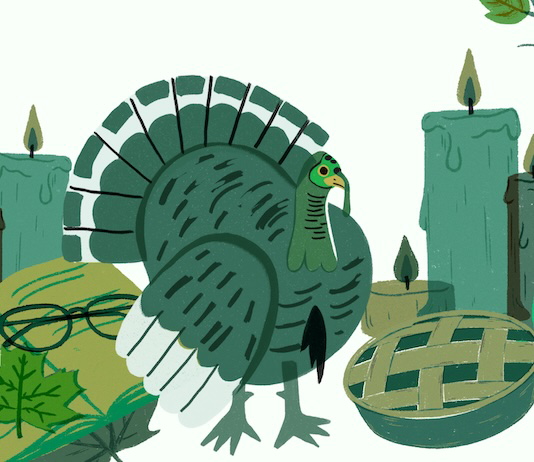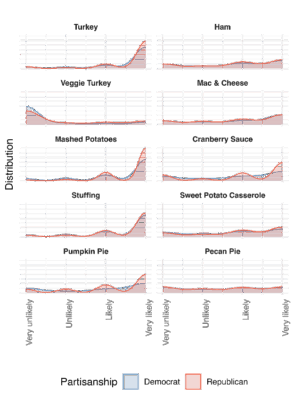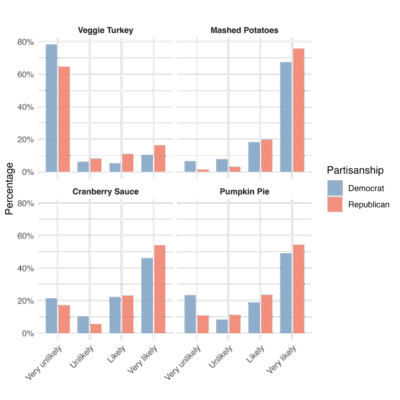Could Thanksgiving Help Depolarize America? A New Survey Offers a ‘Recipe’ for Hope


For years, Americans have been told that the country is polarized. In Washington, disagreement between Republicans and Democrats has produced historic stalemates – including the longest government shutdown on record. In everyday life, social scientists find that partisans increasingly avoid dating, befriending, or even living near people who support the opposite party. For many families, the idea of a child marrying “the other side” can feel like political defection. It’s no wonder that, as Thanksgiving approaches, many Americans brace themselves for tense dinner-table exchanges. Still, 95% of Republicans and 90% of Democrats plan on celebrating Thanksgiving.
Figure 1. Thanksgiving Dish Preference Distribution by Partisanship

According to a survey by the Center for Public Opinion Research at Stetson University (CPOR), the staples of the American Thanksgiving table — turkey, ham, stuffing, mac and cheese, and pies — remain shared traditions across partisan lines. Figure 1 shows no substantial political divide in the dishes Floridians expect to serve, and where differences do appear, they are modest. Republicans were slightly more likely than Democrats to say they planned to eat veggie turkey, mashed potatoes, cranberry sauce, or pumpkin pie (see Figure 2). Those gaps reached statistical significance, but they were far from the kinds of divides that dominate national debate.
Figure 2. Thanksgiving Dish Preferences by Partisanship

Some results ran against political stereotypes. Plant-based foods are often associated with progressive diets, yet Republicans in the survey were marginally more likely to report plans to include a vegetarian turkey option. It’s a small difference, but an informative one, showing that even foods with cultural or partisan stereotypes do not actually divide Americans in their everyday lives.
This may seem trivial. But in a political climate where even the cars Americans drive or the beers they drink increasingly reflect their partisan identities, agreement over something as simple as holiday food is unusual – and quietly instructive.
Of course, this optimism only goes as far as individuals’ willingness across both parties to sit together during Thanksgiving. Some families may feel apprehensive about potential political disagreements at the table, even if most ultimately choose to gather as usual. But the survey suggests that if individuals do gather, they will find that the people they disagree with politically are not all that different when it comes to the rituals and comforts of a shared national holiday.
At a moment when Americans are looking for signs of unity, perhaps the country’s most widely celebrated meal offers a modest reminder: breaking bread – or sharing mac and cheese – still has the power to bring people together. And maybe, in a season defined by gratitude, that small common ground is worth noticing.
Methodology
The survey was conducted online through Qualtrics from Oct. 30 to Nov. 9 and completed by 804 adult Florida residents drawn from Qualtrics’ research panels. Data were weighted to match the state’s population on race, ethnicity, age, gender, education, and DMA region using 2020 Census benchmarks. All regression results include 95 percent confidence intervals. Sample sizes for party subgroups vary, so small differences should be interpreted with caution. More information is available at stetson.edu/crop.

